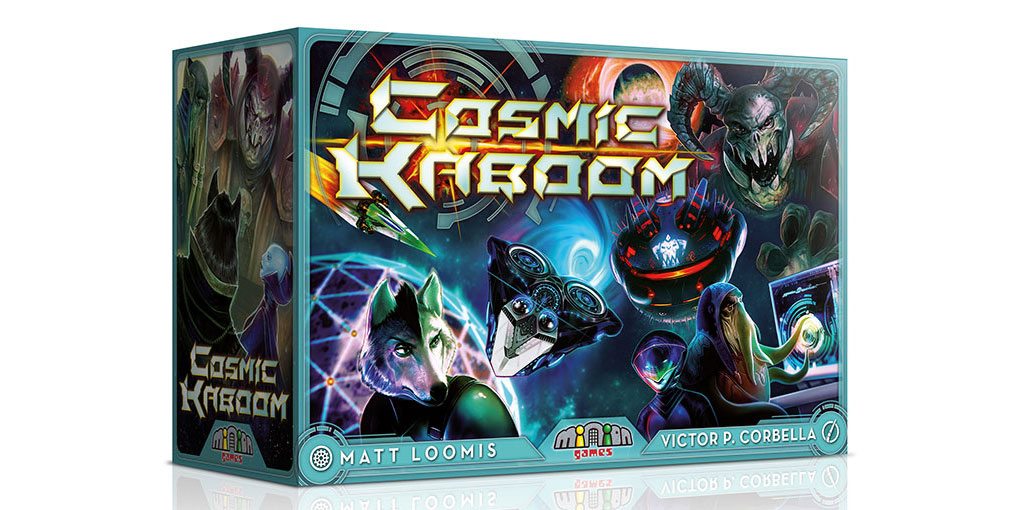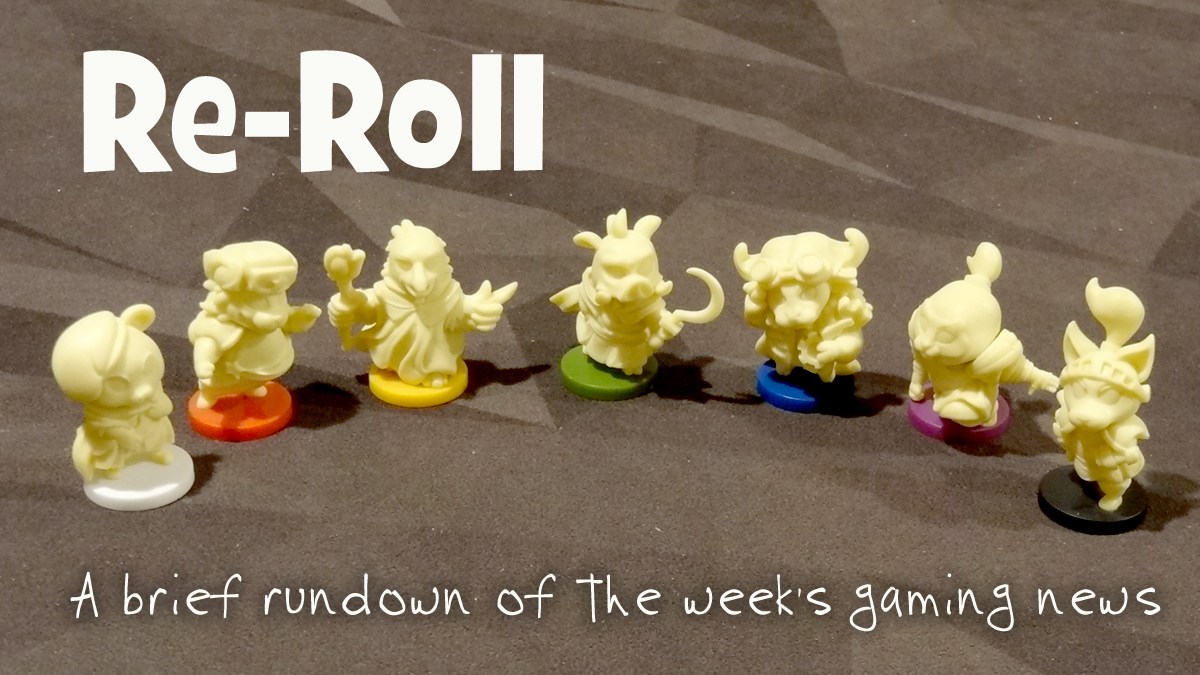The thing about interstellar travel is that it always seems to lead to war–in this case, four factions have discovered how to make a giant, planet-destroying bomb (not a Death Star) and are using it to attack each other. Time to brush off your flicking skills and cause a Cosmic Kaboom.
At a glance: Cosmic Kaboom is a dexerity game for 2 to 4 players, ages 12 and up, and takes about 30 minutes to play. It launched today on Kickstarter, and the base pledge for a copy of the game is $34 $24 (plus shipping). [Correction: the $34 is for a signed copy.] The game can definitely be played with younger players, though it’s best if they can read the advancement cards by themselves, and they should have enough hand-eye coordination to aim and flick.
New to Kickstarter? Read our crowdfunding primer here.
Components:
- 4 Spaceships (small disks)
- 16 Energy Cubes (4 each in 4 colors)
- 4 Energy Crystal tokens (4 colors)
- 12 Planet tiles (large disks, 3 each in 4 colors)
- 1 Space Bomb tile
- 4 Base tiles (4 colors)
- 4 Cargo Hold tiles (4 colors)
- 20 Advancement cards
I played the game using a prototype set, so it did not include any of the final artwork for the cards or the bases and cargo holds. The planet tiles look like they have finished artwork but everything else is preliminary art.
The base and cargo hold tiles pictured on the Kickstarter page each have four square holes that can be used to hold the energy cubes. The planet tiles are marked with 1, 2, and 3 pips–these are used both for determining where the energy crystals will be, as well as the score value of the planets.
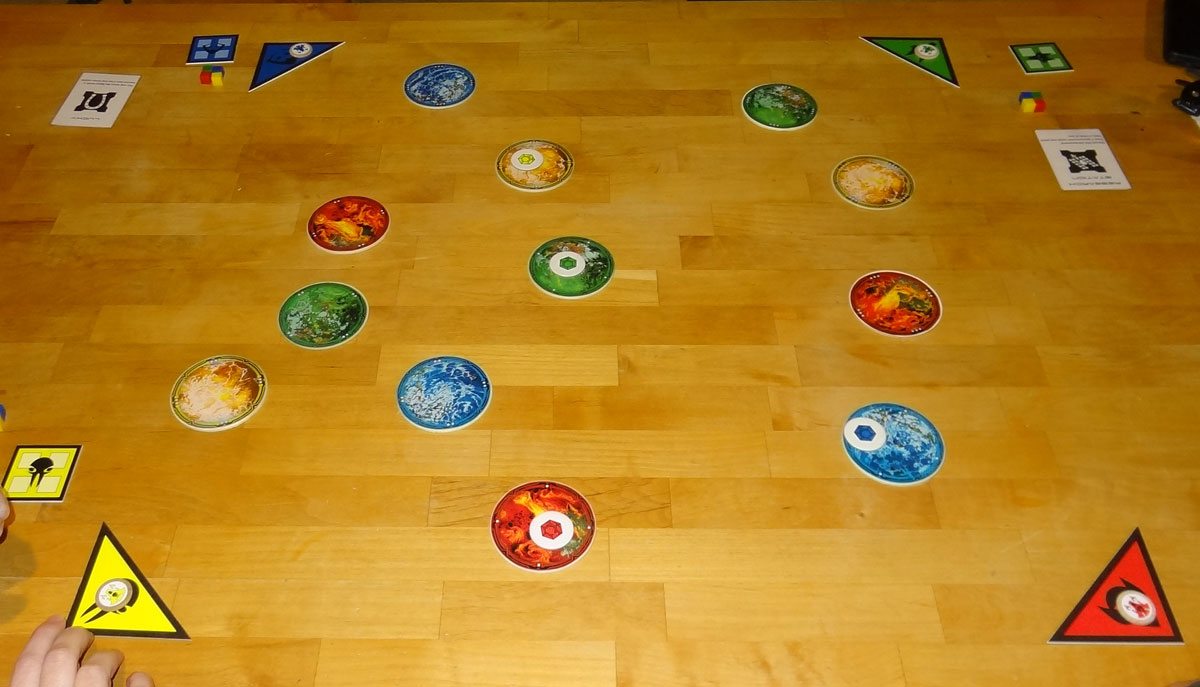
How to Play
You can download a PDF of the rules here.
The object of Cosmic Kaboom is to score the most points by blowing up your opponents’ planets and protecting your own.
To set up, each player chooses a faction and takes the base, cargo hold, planets, and ship of that color. Each player also takes one of each color of energy cube.
The bases are placed so they form four corners of a rectangle or square–this defines the playing area. Cargo holds are placed near the base but outside of the playing area. Each player gets 2 random advancement cards, selects one to keep, and discards the other.
Then, players take turns placing their planets onto the playing area, not touching each other. Once all the planets are placed, the energy crystals are placed onto the matching-colored planets marked with 1 pip. Ships start at the bases.
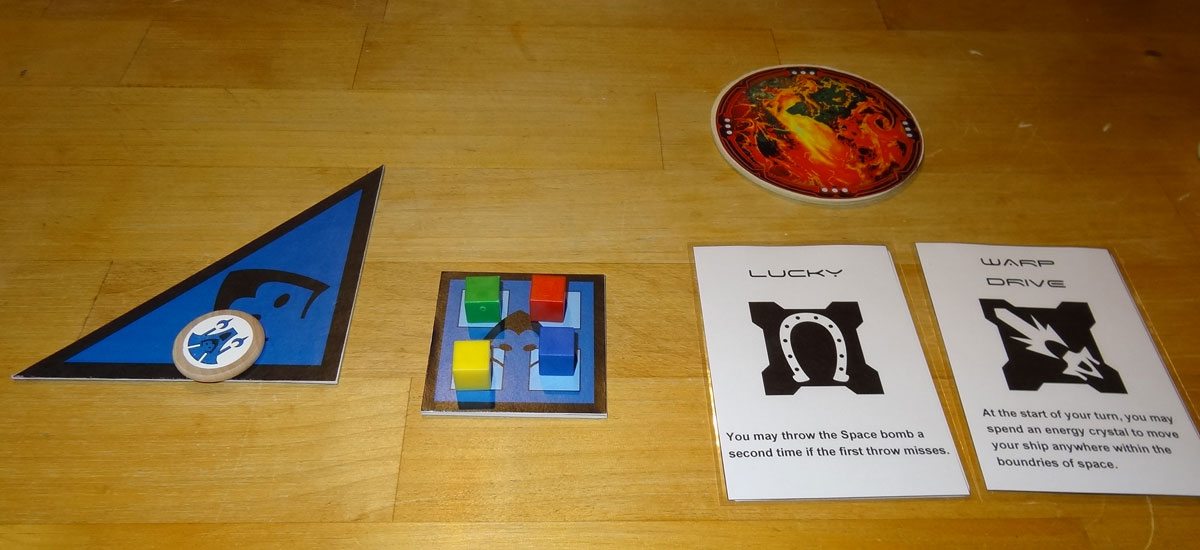
On your turn, you move your ship by flicking it. If you hit a planet with an energy crystal that you haven’t collected yet, then you put that color energy cube into your cargo hold, move the crystal to the next planet of the same color, and get another flick. Otherwise, your turn is over. Also, instead of flicking your ship, you may teleport back to your base and deposit any energy cubes from your cargo hold onto your base. If a ship flies completely outside of the boundaries of the playing area, it is destroyed and you lose all cubes in the cargo hold, and then put your ship back at your base.
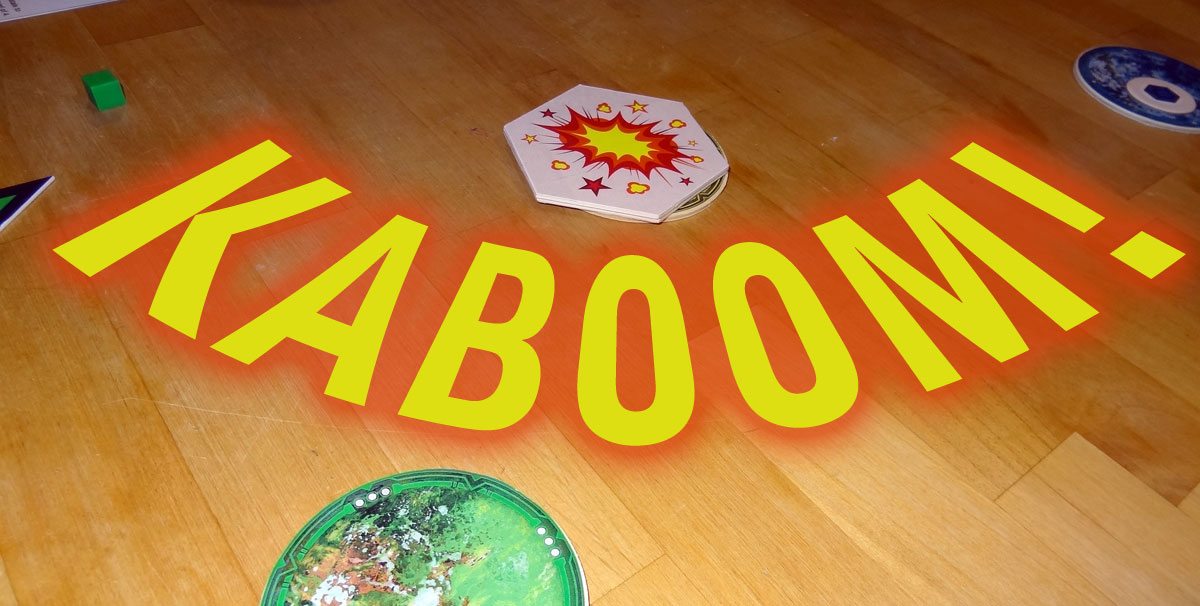
If you have all four energy cubes on your base at the beginning of your turn, then instead of flicking your ship, you launch the Space Bomb. From behind your base, you toss the Space Bomb tile into the playing area. Any planets that the Space Bomb is on top of is destroyed. (Ships are not affected.) You collect any planets that you destroyed, and then remove the energy cubes from your base. Players gain advancement cards each time one of their planets is destroyed. If you missed and didn’t destroy anything, you keep your energy cubes and get to throw the bomb again next turn.
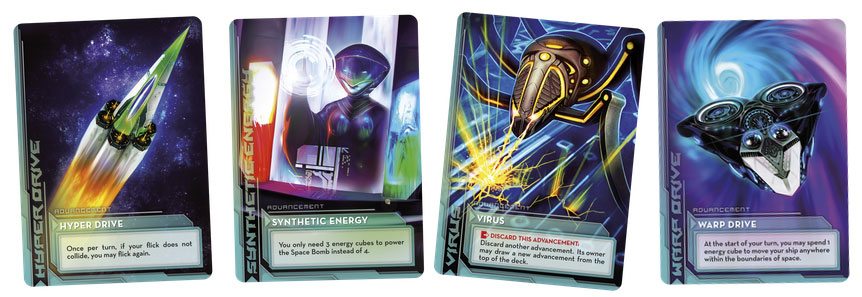
Advancement cards give you various special abilities. Some give passive bonuses and some have to be discarded to be used. Whenever you gain advancement cards, you draw two and choose one.
The game ends either when one player has no more planets or when seven planets have been destroyed.
You get 2 points for each of your surviving planets, and then points for destroying opponents’ planets (3, 4, or 5 points for the 1, 2, or 3 pips). You don’t get any points for destroying your own planets. Highest score wins.
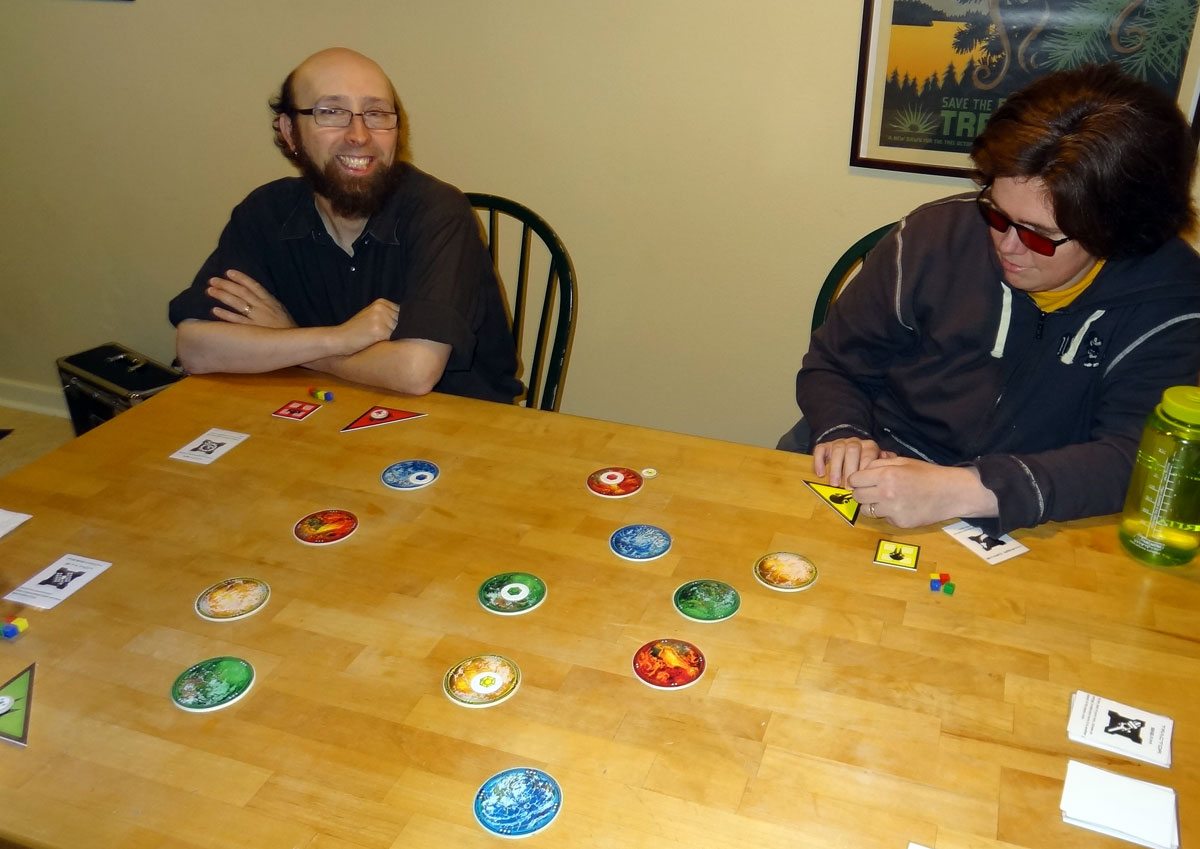
The Verdict
I like dexterity games–flicking, throwing, rolling, balancing–and I’ve played lots of different types. Cosmic Kaboom is one of the first I’ve played that incorporates both the flicking mechanic (for flying the ship) and a tossing mechanic (for launching the Space Bomb), so that was pretty interesting.
The flicking portion itself was fairly straightforward–aim for certain targets (in this case, usually the planets with the crystals) and try not to fall off the edge of the world. The fact that the crystals move around from planet to planet means that your target can shift, but you can also plan ahead to some extent if you think another player is sure to collect a particular crystal before you get to it.
The bomb-tossing is a newer thing. There are card-tossing games (like Maximum Throwdown or the newly launched Monstrous) but I haven’t seen a lot of games where you toss a big cardboard tile. It can be surprisingly difficult to land on a planet even at the beginning of the game when there are a lot of them out there–but of course you don’t want to hit your own, so that limits your options.
Most flicking games I’ve played usually involve hitting the other player’s pieces with your own, whether it’s like Catacombs with heroes and monsters attacking each other, Flick Wars with spaceships chasing each other down, or Disc Duelers with fighters battling it out. In this case, you can knock another player’s ship out of bounds to destroy it and its cargo, but your primary target is to reach the planets to get cubes, and then throw the bomb to blow up the planets.
The advancement cards are what really differentiate the players, because otherwise the four factions have only cosmetic differences. There’s a wide range of abilities–one card lets you launch a bomb with only 3 cubes instead of 4. One lets you take another free flick if you don’t hit anything. Your mix of advancements can make a big difference in the game, so while it does add variety to the gameplay it can also feel somewhat unbalanced if a player has a particularly good combination. (It can be a nice catch-up mechanic, though, since you get a card whenever you lose a planet.)
Overall, while Cosmic Kaboom isn’t my favorite dexterity game, I’ve had fun playing with the prototype and it’s a solid dexterity game. If you like games that involve flicking disks around the table, then you should check out the Kickstarter page and see if you like the theme and rules.
